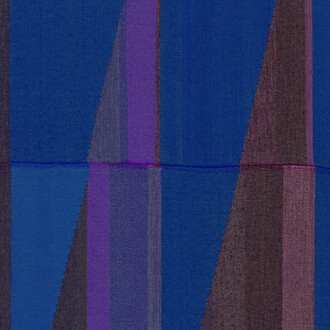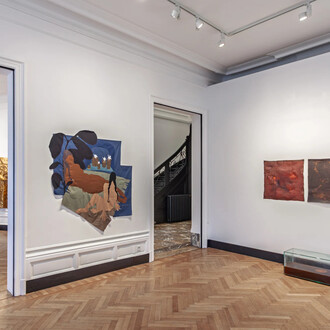For his first solo exhibition with the gallery, American artist Richard Phillips presents a new body of paintings based on Fascist era Roman sculptures and the artwork of Cy Twombly
The sculptural images are sourced from the artist’s photos of the Palazzo Della Civiltà and the Foro Italico, both of which were commissioned by Benito Mussolini for the Mostra della Civiltà Romana during the 1942 World Fair and for the Olympic Games of 1944 respectively. Using a vertical halftone graphic image, the painted wax oil emulsion paintings physically reconstruct in optical color the anti-modernist sculptures intended to honor Rome's neo-classical past.
The other series comes from close ups of Cy Twombly's Roman Salalah paintings of 2005/07 and his Final paintings of 2012. The compositions are inspired by the detailed documentary images found in artists catalogs designed to show mastery. Painted with a pallet knife, the pigmented surfaces create a physical relief articulating both the presence of paint and absence of movement. In his definitive article on action painting, Harold Rosenberg wrote: “ What was to go on the canvas was not a picture but an event“. With Phillips’ paintings, the event is the careful remaking of the picture—and the viewers careful consumption.
Hung together, these paintings examine modernism's revelations with the same skepticism as critic Bruno Latour, whose book, We Have Never Been Modern, informed the exhibition. When qualifying the term modernity in the beginning of his essay, Latour writes: “Modernity comes in as many versions as there are thinkers or journalists, yet all its definitions point, in one way or another, to the passage of time. The adjective 'modern' designates a new regime, an acceleration, a rupture, a revolution in time. When the word 'modern', 'modernization', or 'modernity' appears, we are defining, by contrast, an archaic and stable past. Furthermore, the word is always being thrown into the middle of a fight, in a quarrel where there are winners and losers, Ancients and Moderns. 'Modern' is thus doubly asymmetrical: it designates a break in the regular passage of time, and it designates a combat in which there are victors and vanquished.” Phillips paints an equally lopsided and oscillating image of the future with all the hyper realism of his figurative past.
















